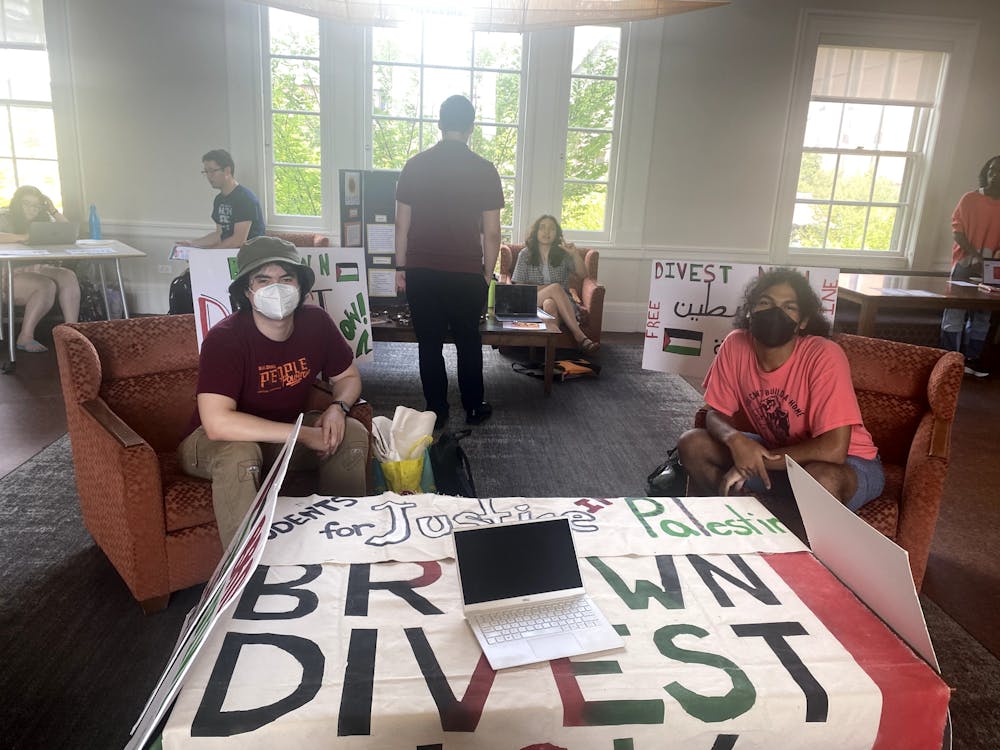The Brown Activist Coalition hosted its second Activist Coalition Conference on Saturday, creating a space for progressive campus organizations to share their missions with interested students and discuss inter-club collaborations.
Among the groups involved in the event were Students for Educational Equity, Sunrise Brown, the Teaching Assistant Labor Organization and Students for Justice in Palestine.
‘Easier to navigate’: A new recruitment format
Each organization at the conference had a booth for students to visit, a format that SEE Co-President Meg Henning ’25 said was “more flowy and relaxed” than BAC’s last conference. That conference, held in January, was structured more as a speaker series, where “each group came and spoke to students about what their organization was about,” she added.
“This seemed like a better and more interactive way for people to get to know each other one-on-one, rather than a more lecture-based feel,” Henning said.
The change was not lost on attendees. “I like that it lacked a little bit of structure,” said Eugenia Bamfo ’27, who attended the conference to explore possible organizations to join. “You’re free to explore different things.”
“We help the coalition organize all the different activist groups on campus to get together and do events like this in hopes of bringing students who are interested in activism to this space,” Henning said. “There are so many groups that they can choose from, but when we’re all together, they can pick one that might align with their goals.”
Organizers and attendees alike commented on preferring the more intimate BAC Conference to the wider Activities Fair.
“At the Activities Fair, you might feel overwhelmed, but here, it’s easier to navigate. You can just focus on the activist groups (and) find whatever you're looking for,” said Chloe Chen ’24, a representative for End Sexual Violence @ Brown.
“At the club fair, everything’s hitting you all at once, but here you know that (these are) activist groups, and you know what you’re looking at and looking for. It’s way more put together,” said Shamariah Smith ’27, who attended the conference.
Events like the conference also give groups a chance to broadcast their mission when they might not otherwise be able to. Due to its limited membership, the Student Labor Alliance has not been allowed to set up a table at the club fair for the past two years, according to Peter Haynes ’26, a representative for the organization.
Unity among activist groups
Gabriela Venegas-Ramirez ’26, a representative from SLA, felt that the conference not only helped attract newcomers but also “facilitated a lot of connections between groups.”
“We talk online a lot,” she said, “but it’s especially helpful to be able to really see each other and connect in person.”
Lily Chahine ’24, a representative from the mutual aid and anti-prison organization Railroad, said that “it’s hard at Brown when everyone’s pigeonholed into different organizations, but (the) issues (they focus on) all impact each other.”
“We’re trying to do more collaborations and expose the ways that prison and carceral structures intersect with other issues like education and homelessness,” she added.
“Our goals are not necessarily separate,” said Isabella Garo ’24, co-founder and community co-lead of Sunrise Brown. She explained how SLA can provide insight into issues of labor in the green transition while SEE addresses the educational inequities and marginalization of low-income people and people of color. All of these issues can tie into environmental injustice.
“As a coalition, our organizations are greater than the sum of their parts when we work together, share our resources and even share our members, since there are several people in the coalition who are members of multiple (organizations),” Garo added.
“When we organize a protest, getting all coalition members to go, not just one group, makes us a lot bigger in numbers and power,” Henning said. “The power in people has been really awesome, and we’re hoping to continue that this semester.”
Attendees picked up on the growing sense of unity between the groups.
“I love to see cooperation instead of division between activist groups,” Matteo Papadopoulos ’26 said. “It’s a lot easier to go up against a large institution when all of the activism groups have a similar goal.”
BAC also acts as a vessel through which organizations can share information with one another. “One of the worst parts of student organizing is when the turnover happens and you have to relearn all these lessons that people have learned previously,” Chahine said. “Increasing communication across different groups and seeing where we can support each other makes a lot of sense.”
TALO is working with the Graduate Labor Organization to institutionalize communication between groups by creating the Student Activist Organizing School, a six-week course led by professional union staffers, according to Ronnie Shashoua ’25, an organizer for TALO.
The school “is obviously very relevant for people interested in labor organizing, but it’s also for anyone interested in organizing more generally,” Shashoua said. “It’s going to be a how-to on how to build power, how to reach out to the people that you're working with and how to really build a campaign that works best for the people you’re trying to help.”
Additionally, groups like Resource Generation @ Brown provide organizers with an educational basis to underpin more direct organizing by enabling them to talk about their class background, according to Alec Lacerte ’25, a representative from RG.
“I try to make it clear that RG is not a one-and-done,” he added. “Interrogating and talking about wealth is just one tiny aspect of activism, and if people are joining RG they should also be getting involved with other organizing groups.”
According to Simo Klein ’24.5, another organizer for RG, addressing wealth inequality from the outset is a form of “preventative care” to avoid “harm that can happen in activist spaces and cause so much more fragmentation.”
Uniquely Brown
Though coalition-building is an essential aspect of any activism, attendees of the event highlighted that BAC represented both their perceptions of and hopes for Brown as a university.
“When I was looking at Brown, I knew that it was very liberal and that students here care about a lot of issues,” Bamfo said. “I never got to get into protests and organizing in high school, so I’m really hoping that college can be that place where I can become an organizer.”
“This isn't something that you can find everywhere. Not every city or school has a real activist community, even around problems that they do struggle with,” Smith said. “It's great to see that the people here care about problems that people elsewhere struggle with.”
“It’s very powerful that the coalition can not only be a space where we’re supporting each others' work, but where we're also actively caring for each others’ wellbeing,” Klein said.
Papadopoulos added that BAC’s dedication to “bolstering student voices and student activism on campus” is part of “what makes Brown, Brown.”

Katie Jain is a University News editor from New Jersey overseeing the graduate student life beat. She is a senior concentrating in International and Public Affairs and History.





